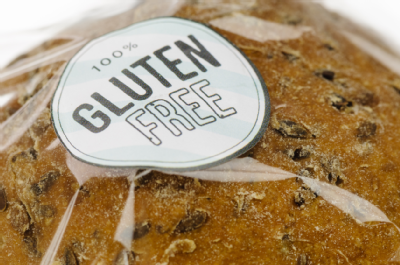Food labels
Perhaps in the past you have never paid much attention to food labels, but now you need to, and these labels and logos are now your friend. Once you understand how these work and what you’re looking for, it’ll get quicker and easier to make safe choices for your gluten free diet.
Gluten free labelling
 There is a law that covers the use of the labelling term gluten free. When you see gluten free on a label, you know these foods are suitable on a gluten free diet.
There is a law that covers the use of the labelling term gluten free. When you see gluten free on a label, you know these foods are suitable on a gluten free diet.
The term 'gluten free' is covered by law and can only be used on foods which contain 20 parts per million (ppm) or less of gluten. You might see this on specialist substitute products like breads, flour and crackers, which may contain gluten free wheat starch, as well as processed foods made from naturally gluten free ingredients such as soups, sausages and ready meals. Uncontaminated oat products can also be labelled gluten free.
Read more about the law on gluten free.
Ingredients list
The good news is that you can easily tell if a product contains gluten.
All packaged foods in the UK and the EU are covered by labelling laws which include rules around the allergen information that has to be provided on the label. This means that you can tell from the label whether a product contains ingredients that contain gluten.
There are two types of prepackaged foods which have different labelling rules and it can be difficult to distinguish the difference:
- ‘prepacked food’ are foods which have been put in packaging before being offered for sale to the customer
- ‘prepacked food for direct sale’ are foods which are packed on the premises the food will be sold such as a sandwich that is packaged in the shop it will be sold.
All prepacked foods require a food label and the requirements of the Food Information Regulations mean that you can tell from a label whether a product contains a gluten containing ingredient or not.
All deliberately used ingredients must be listed in the ingredients list in order of their amount (greatest first). Gluten containing ingredients are one of the 14 listed allergens that must be emphasised in the ingredients list, therefore if something containing gluten is used as an ingredient, it must be listed and clearly emphasised, for example in bold lettering, in the ingredients list, no matter how little of it is used. Manufacturers will name the specific grain used, so you will see these words on the ingredients list if they are in the product:
- wheat
- rye
- barley
- oats
- spelt
- khorasan wheat (commercially known as Kamut®).
Some manufacturers will also include an 'Allergy Advice' panel, which may contain additional information. We have over 100,000 products with ingredients list you can search on our Food and Drink Information page.
Exemptions
Always there is the potential for confusion, in this case there are some ingredients which are made from a cereal containing gluten where the grain is processed in such a way that the gluten is removed. These ingredients are safe for people with coeliac disease and therefore it is not necessary for the manufacturer to list the cereal they first came from.
The following ingredients are safe for people with coeliac disease:
- glucose syrups derived from wheat or barley including dextrose
- wheat based maltodextrins
- distilled ingredients made from cereals that contain gluten, for example, alcoholic spirits.
 Although these ingredients can be made from cereals containing gluten, manufacturers do not have to label them as such. Some manufacturers still list these, for example ‘glucose syrup from wheat’ or ‘wheat dextrose’. These ingredients are gluten free and are suitable for people with coeliac disease. So, you may see wheat listed against these types of product but in actual fact they are safe for you to eat, if in doubt call our helpline for assistance.
Although these ingredients can be made from cereals containing gluten, manufacturers do not have to label them as such. Some manufacturers still list these, for example ‘glucose syrup from wheat’ or ‘wheat dextrose’. These ingredients are gluten free and are suitable for people with coeliac disease. So, you may see wheat listed against these types of product but in actual fact they are safe for you to eat, if in doubt call our helpline for assistance.
‘May contain’ labelling
Manufacturers are given guidance by the Food Standards Agency on when to label a product with a ‘may contain’ statement.
They may use labelling such as:
- may contain traces of gluten
- made on a line handling wheat
- made in factory also handling wheat
- not suitable for people with coeliac disease/a wheat allergy due to manufacturing methods.
When you see one of these statements on a product, the manufacturer has decided that there is a risk that the product could be contaminated with gluten. If you’re unsure, you can contact the manufacturer directly if you would like further information on the suitability of the product. We also speak to manufacturers about their products, so you can call our helpline for advice.
Coeliac UK videos on food labels
We have developed two short videos with handy tips to help you work out which foods are right for you:
Explains what information is on food products and how this can help you identify which foods are suitable for you to eat:
Addresses some of the common myths surrounding the gluten free diet:
Crossed Grain symbol
Our Crossed Grain symbol is a helpful, quick and easy way of identifying foods you can eat. Food products that have the Crossed Grain symbol on the packaging are gluten free and safe for people with coeliac disease.
There are different types of licence for the symbol based on where the product is sold and what ingredients are in the product. You can tell what kind of licence the product has by the licence number which will be shown alongside the symbol. Read more about the Crossed Grain symbol.